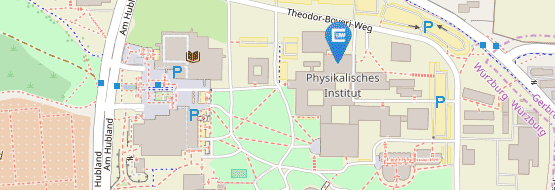TEP Seminar - Pavel Avdienko
Electrically tunable single-photon sources based on MBE grown InAs/InGaAs QDs and QD-molecules for telecom O-band
| Date: | 02/06/2025, 3:30 PM |
| Location: | A034 |
| Speaker: | Pavel Avdienko, TU Munich |
Vertically stacked pairs of tunnel-coupled quantum dots (QDs) — quantum dot molecules (QDMs) — are excellent candidates to form multi-spin qubits that are less susceptible to decoherence than single spins [1–5]. In particular, the singlet–triplet (S−T0) logical qubit formed by two spins [1–3] occupying the hybridized orbitals of a tunnel-coupled quantum dot is expected to provide more than an order of magnitude longer coherence times (T2) than observed for single QDs due to the existence of a sweet spot at which the S−T0 qubit energy is insensitive to magnetic and electrical noise. QDMs have also been theoretically suggested to facilitate the deterministic (on-demand) generation of 2D photonic cluster states, a key resource needed for measurement- based quantum computation [3]. To facilitate these applications, QDMs must be operated in a regime where they are stably occupied by two spins, while the inter-dot tunnel coupling of s-orbital states can be freely tuned, for example, using a gate electrode [4,5].
In the seminar, we experimentally probe electrically tunable quantum orbital couplings in optically active InAs- InGaAs QD-molecules emitting in the telecommunication O-band at T = 10K. Individual InAs QD layers were first grown by MBE on GaAs(001) substrates using the Stranski–Krastanov growth mode and overgrown by a InGaAs strain-reducing layer. We observed wide tunability of the emission wavelength exceeding ~20 nm via the quantum-confined Stark by cladding the QD layer using AlGaAs barriers. Upon tuning the internal electric field in the samples containing InAs-InGaAs QD-molecules emitting in the O-band, we observe clear anticrossings of different charge state transitions. Comparison with theoretical predictions reveals that the excitonic anticrossings arise from tunnel coupling of different orbital states in the molecule and the multiplicity of lines arises from optically induced charging of the molecule.
References
- Economou et al., PRL 105, 093601 (2010).
- Gimeno-Segovia et al., Phys. Rev. Lett. 123, 070501 (2019).
- Raussendorf and Briegel, Phys. Rev. Lett. 86(22), 5188 (2001).
- Bopp et al., Phys. Rev. B 107(16), 165426 (2023)
- Schall et al., Adv. Quantum Tech. 4(6), 2100002 (2021)


